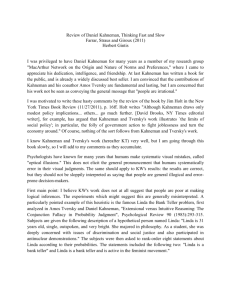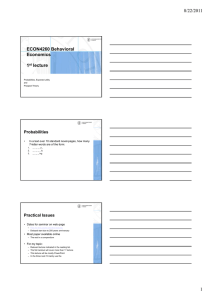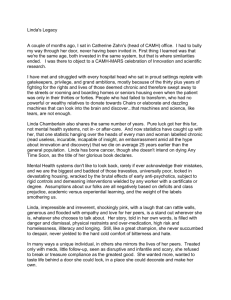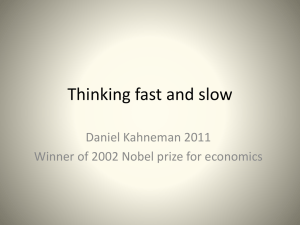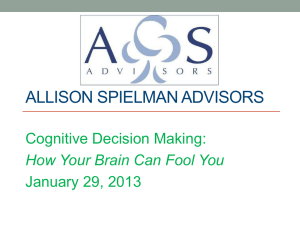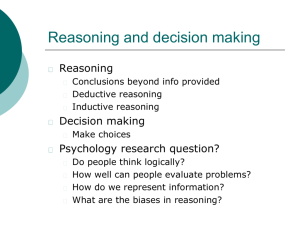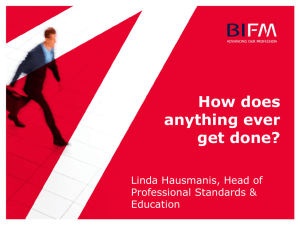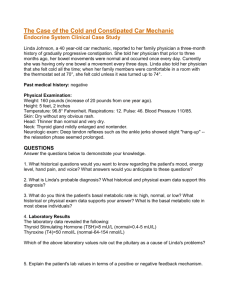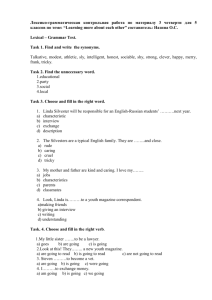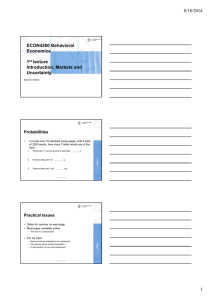First lecture Markets
advertisement
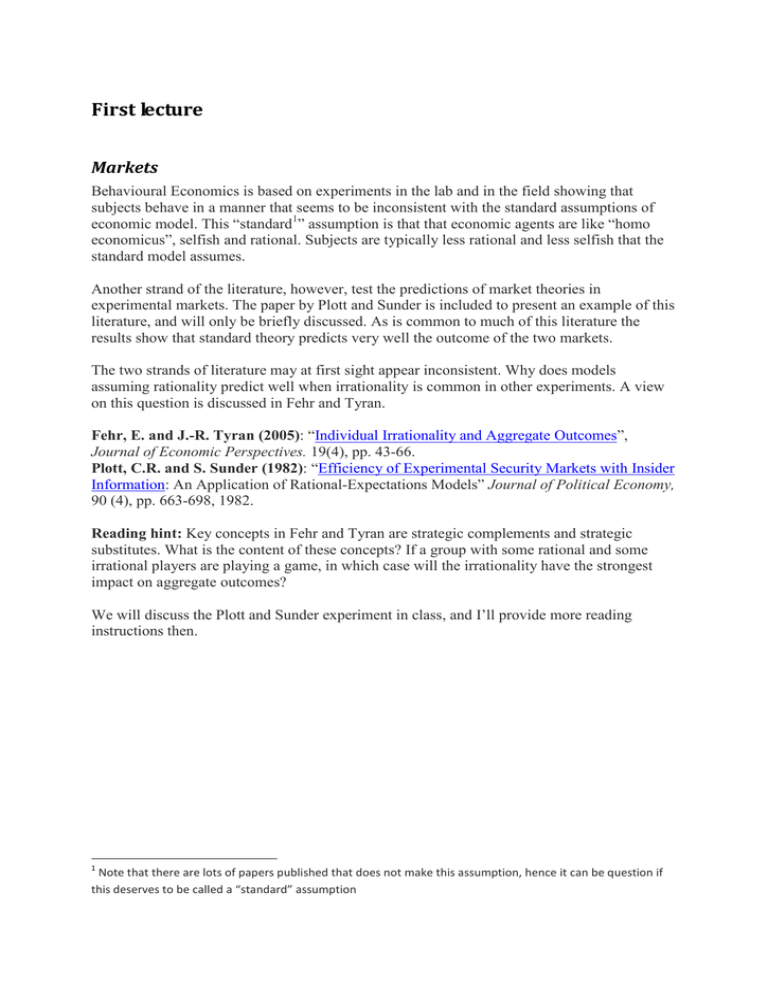
First lecture Markets Behavioural Economics is based on experiments in the lab and in the field showing that subjects behave in a manner that seems to be inconsistent with the standard assumptions of economic model. This “standard1” assumption is that that economic agents are like “homo economicus”, selfish and rational. Subjects are typically less rational and less selfish that the standard model assumes. Another strand of the literature, however, test the predictions of market theories in experimental markets. The paper by Plott and Sunder is included to present an example of this literature, and will only be briefly discussed. As is common to much of this literature the results show that standard theory predicts very well the outcome of the two markets. The two strands of literature may at first sight appear inconsistent. Why does models assuming rationality predict well when irrationality is common in other experiments. A view on this question is discussed in Fehr and Tyran. Fehr, E. and J.-R. Tyran (2005): “Individual Irrationality and Aggregate Outcomes”, Journal of Economic Perspectives. 19(4), pp. 43-66. Plott, C.R. and S. Sunder (1982): “Efficiency of Experimental Security Markets with Insider Information: An Application of Rational-Expectations Models” Journal of Political Economy, 90 (4), pp. 663-698, 1982. Reading hint: Key concepts in Fehr and Tyran are strategic complements and strategic substitutes. What is the content of these concepts? If a group with some rational and some irrational players are playing a game, in which case will the irrationality have the strongest impact on aggregate outcomes? We will discuss the Plott and Sunder experiment in class, and I’ll provide more reading instructions then. 1 Note that there are lots of papers published that does not make this assumption, hence it can be question if this deserves to be called a “standard” assumption Expected utility and conjunction fallacy The remainder of part I will discuss decisions under uncertainty. How do people choose when outcomes are uncertain? But before addressing that question directly, we first consider the perception of uncertainty. Theories of statistical inferences are after all hard to learn for many university students, so do people really understand the alternatives they have to choose from? The very widely cited paper by Tversky and Kahneman argues that people, even those we expect to understand sophisticated probability theory, in their behavior violates even the most fundamental laws of probability. Gigerenzer et.al. is critical to this claim and argues that people are much smarter than Tversky and Kahneman claims. Tversky A. and D. Kahneman (1984). “Extensional versus Intuitive Reasoning: The Conjunction Fallacy in Probability Judgement," Psychological Review, 91, 293-315. Gigerenzer, G., R. Hertwig, U. Hoffrage, P. Sedlmeier (2008). Cognitive Illusions Reconsidered, Handbook of Experimental Economics Results, Vol.1, Ch 109, 1018-1034. As a start for reading these papers: Find the Linda case in Tversky and Kahneman (1984). Why are the results in this study contradicting standard probability theory? Gigerenzer et al (2008) reformulate the Linda problem and get different results. What is the key difference between the two formulations and what do you think this implies for the practical implications of Tversky and Kahneman’s result? 1/21/2013 ECON4260 Behavioral Economics 1st lecture Introduction, Markets and Uncertainty Kjell Arne Brekke Probabilities • In a text over 10 standard novel-pages, how many 7-letter words are of the form: 1. _ _ _ _ _n_ 2. _ _ _ _ _ ly 3. _ _ _ _ ing Practical Issues • Dates for seminar on web-page • Most paper available online – The rest in a compendium • For my topic: – – – – Relevant lecture indicated in the reading list. The fist handout will cover more than 1st lecture This lecture will be mostly PowerPoint In the three next I’ll mainly use the blackboard. 1 1/21/2013 Three main topics • Decision theory (Lectures 1-4) – Decisions under uncertainty • Time preferences (Lectures 5-8) – 10$ today versus 11$ tomorrow – 10$ ten days from versus 11$ after 11 days • Justice / Non-selfish behavior (L 9-13) – Share 100 kroner with a recipient/responder – Dictators share – Responders reject unfair offers • But we will discuss experimental markets today. Time preferences / Self control • It is a good idea to read the papers before the lectures, and to allocate work evenly over the semester – Most students know – Some lack the self control to do it. • But then: – Who is the ’self’ if not the student? – If it is the student, who is the ’self’ controlling? • Theories of multiple selves • Enjoyable read (not curriculum): Robert Kurzban (2011) ”Why everyone (else) is a hypocrite” Princeton UP Study pre-commitment technique • Suppose at the start of the semester you decide to – Solve all seminar exercises in advance – Read all relevant papers on the reading list before each lecture – Attend all lectures and seminars • But you know that you (maybe) will not follow through – And that you will regret as exams are approaching • Make a contract with another student – Attend at least 90% of lectures and seminars – have someone to sign. – Have written answers to 80% of all seminar problem (signed) • If the contract is not met – give 1000 kroner to an organization that you disagree strongly with. • Homo oeconomicus would not need this contract – Why do we need it? Institutt for statsvitenskap 2 1/21/2013 Social preferences • When you watch someone in pain and when you yourself is in pain, some of the same neurons light up in your brain. • Old wisdom: We share others pain, sorrow, happiness. – But may enjoy their pain if they have done us wrong • Is it then reasonable to assume my utility only depend on my own consumption? • Enjoyable read (no curriculum): Franz de Waal (2009) ”The age of empathy.” Three river press – Claim: Morality evolved from the ability to mimic. A class room experiment • If more than 40, sit together in pairs • About 1/3 will be sellers, and 2/3 buyers • Sellers has a cost 1 and buyers has value 4 – – – – If a seller sell at p, he/she earns p-1 twist The buyer earn 4-p twist in paid rounds Sellers can only sell 1 unit, and buyers only buy 1 unit. The price has to be an integer – Twists are non-divisible • Double auction – Sellers can announce a selling price • Any buyer can accept a standing offer – Buyers can announce a buying price • Any seller can accept standing offers – All prices can be changed until a deal is made Private information • We have three piles of information cards – Two pile with state Low – One piles with state High • If a High is drawn the value for byers is 7 • If Low is drawn, the value for buyers is 3 • Some information cards are empty – Only half of you will be informed about the true state – Do not show your card to anyone else or directly reveal what you know. • Otherwise the procedure is as before. Institutt for statsvitenskap 3 1/21/2013 Plott and Sunder • Similar experiment with private information • What do subjects act on? – Prior information - 2/3 probability of High – Rational expectations – the true state (even for those who got a blank card) • Results support rational expectations – There is not a perfect fit of theory and data • A large litterature on experimental markets – Theories based on homo economicus perform very well – Markets works better than the theory predicts • How do we reconcile this with the «irrationality» that is the topic of the current course? Fehr and Tyran: Money Ilusion Institutt for statsvitenskap 4 1/21/2013 Back to decision theory How to make the optimal decision in theory • For each alternative action: – Make an assessment of the probability distribution of outcomes – Compute the expected utility associated with each such probability distribution – Choose the action that maximize expected utility • How do people make probability assessment? 5 1/21/2013 Fundamental law of statistics • If the event A is contained in B then Pr(A) ≤ Pr(B) • Example: An urn contains Red, Blue and Green balls. A ball is drawn at random Pr(Red OR Blue) ≥ Pr(Red) • Conjunctions: A&B is contained in B Pr(A&B) ≤ Pr(B) • Applies to all alternatives to probability, like Belief functions and non-additive measures Linda • “Linda is 31 years old, single, outspoken and very bright. She majored in philosophy. As a student, she was deeply concerned with issues of discrimination and social justice, and also participated in anti-nuclear demonstrations.” – – – – – Linda Linda Linda Linda Linda is a teacher in elementary school is active in the feminist movement (F) is a bank teller (T) is an insurance sales person is a bank teller and is active in the feminist movement (T&F) • Probability rank (1=most probable): – Naïve: T&F : 3,3; T : 4,4 – Sophisticated: T&F : 3,2; T : 4,3. • Conjunction rule implies – Rank T&F should be lower than T (Less probable) Bill • Bill is 34 years old. He is intelligent but unimaginative, compulsive, and generally lifeless. In school he was strong in mathematics but weak in social studies and humanities. – – – – – – – – Bill Bill Bill Bill Bill Bill Bill Bill is a physician who play poker for a hobby is an architect is an accountant (A) plays jazz for a hobby (J) [Rank 4.5] surfs for a hobby is a reporter is an accountant who play jazz for a hobby (A & J) [Rank 2.5] climbs mountains for a hobby. 6 1/21/2013 Indirect and Direct tests • Indirect versus direct – Are both A&B and A in same questionnaire? – Paper show that direct and indirect tests yield roughly the same result. • Transparent – Argument 1: Linda is more likely to be a bank teller than she is to be a feminist bank teller, because every feminist bank teller is a bank teller, but some bank tellers are not feminists and Linda could be one of them (35%) – Argument 2: Linda is more likely to be a feminist bank teller than she is likely to be a bank teller, because she resembles an active feminist more than she resembles a bank teller (65%) Sophistication • Graduate student social sciences at UCB and Stanford • Credit for several statistics courses – ”Only 36% committed the fallacy” – Likelihood rank T&F (3.5) < T (3.8) ”for the first time?” • But: – Report sophisticated in Table 1.1, no effect As a lottery • ”If you could win $10 by betting on an event, which of the following would you choose to bet on? (check one)” – ”Only” 56 % choose T&F over F 7 1/21/2013 Extensional versus intuitive • Extensional reasoning – Lists, inclusions, exclusions. Events – Formal statistics. • If A B , Pr(A) ≥ Pr (B) • Moreover: ( A & B) B • Intuitive reasoning – Not extensional – Heuristic • Availability • Representativity. Representative versus probable • ”It is more representative for a Hollywood actress to be divorced 4 times than to vote Democratic.” (65%) • But • ”Among Hollywood actresses there are more women who vote Democratic than women who are divorced 4 times.” (83%) Representative heuristic • While people know the difference between representative and probable they are often correlated • More probable that a Hollywood actress is divorced 4 times than a the probability that an average woman is divorced 4 times. • Thus representativity works as a heuristic for probability. 8 1/21/2013 Availability Heuristics • We assess the probability of an event by the ease with witch we can create a mental picture of it. – • Works good most of the time. Frequency of words – – – – A: _ _ _ _ ing (13.4%) B: _ _ _ _ _ n _ ( 4.7%) Now, and hence Pr(B)≥Pr(A) But ….ing words are easier to imagine Predicting Wimbledon. • Provided Bjørn Borg makes it to the final: – He had won 5 times in a row, and was perceived as very strong. • What is the probability that he will (1=most probable) – Lose the first set (2.7) – Lose the first set but win the match (2.2) • It was easier to make a mental image of Bjørn Borg winning at Wimbledon, than losing. We like small samples to be representative • • • Dice with 4 green (G) and two red (R) faces Rolled 20 times, and sequence recorded Bet on a sequence, and win $25 if it appear 1. RGRRR 2. GRGRRR 3. GRRRRR • 33% 65% 2% Now most subject avoid the fallacy with the transparent design 9 1/21/2013 More varieties • Doctors commit the conjunction fallacy in medical judgments • Adding reasons – NN had a heart attack – NN had a heart attack and is more than 55 years old • Watching TV affect our probability assessment of violent crimes, divorce and heroic doctors. (O’Guinn and Schrum) The critique from Gigerenser et.al • The Linda-case provide lots of irrelevant information • The word ’probability’ has many meanings – Only some corresponds to the meaning in mathematical statistics. • We are good at estimating probabilities – But only in concrete numbers – Not in abstract contingent probabilities. – Of 100 persons who fit the description of Linda. • How many are bank tellers? • How many are bank tellers and active in the femininist movement? – Now people get the numbers right More on Linda • In Kahenman and Tversky’s version even sophisticated subject violate basic probability • The concrete number framing removes the error • Shleifer (JEL 2012) in a review of Kahneman’s recent book (Thinking fast and slow.) – «This misses the point. Left to our own devices [no-one reframes to concrete numbers] we do not engage in such breakdowns» Institutt for statsvitenskap 10 1/21/2013 The base rate fallacy • Suppose HIV-test has the following quality – Non-infected have 99.9% probability of negative – Infected always test positive – 1 out of 1000 who are tested, are infected. • If Bill did a HIV-test and got a positive. What is the probability that Bill are in fact infected? – Write down your answer. Suppose we test 1001 persons • Statistically 1 will be infected and test positive • Of the 1000 remaining, 99,9% will test negative, and one will test positive. (on average) • If Bill did a HIV-test and got a positive. What is the probability that Bill is in fact infected? – Write down your answer. An advise • If you want to learn statistical theory, especially understand contingent probabilities and Bayesian updating: – Translate into concrete numbers • This will enhance – Your understanding when you study it, and – Your ability retain what you have learned 10 years from now. 11
